
(Photos by Becky Jo)
Humans are so weird. We pop out all clean and looking like fresh, blank slates, but really, there’s a lot already going on in there. I love when humans are surprising, and that’s probably the best thing about being a parent. Just watching them become whatever seed was already planted inside.
Let’s take the youngest here. She’s that kid that while you teach her things, you might think, “This isn’t ever going to take.” Then one day she decides that she’s got it completely down. One day she decided she was potty trained, and she was. That was that. Same with swimming, reading, and now biking. It took me four years and one day to teach her to ride a bike. Alternatively, it was four years of me confused and trying to re-word and explain the same concepts over and over — then a single day of her deciding she was a bike rider.
When “The Incident” happened, she was riding, but not quite ready to ride to school on her own bike, and she could only ride a few meters at a time. We are over a mile from our “walking school” and must cross two busy streets, one being Lombard/Hwy 30. So I called around to local bike shops looking for one of those tag-a-long tandem hitch bikes, hoping for a used one to try out, but no one had one in stock at the time. I checked Craigslist, and no luck there either unless I wanted to go to the coast (which is tough without a car). So, I relented and ordered from Amazon, thinking for sure this was going to be a total waste of money.
Advertisement
If there’s such a thing as pre-emptive buyer’s remorse, I had it. I really thought it was a load of crap that the tag-a-long is also labeled a “bike trainer” but wow, was I wrong. After a few weeks of teetering to and from school together, her balance behind me got better, and it directly translated to her balance being better on her own bike and riding on her own.
After just a week on the tag-a-long we went back over to Kenton Cycle, got her a better fitting bike, and, at her request, practiced daily at the park. Christmas break came, and she asked to start riding her own bike to school after break. We haven’t used the tag-a-long since.
We have also reached the limit of my ability to teach her much more. For example, I was curious about proper traffic signaling methods. I’m old school and still use the left-arm, 90 degree signal for a right turn, but I see now right arm is acceptable? I’m also finally getting used to the sound of bells as passing signals; but I still taught her the old, “on your left” call out. I can admit when I’m outmoded, and she could benefit from a different teacher.
With spring and summer camps on my mind, are you aware of any that teach bike riding and safety? What should I be looking for in a comprehensive kids biking camp?
As always, you’re the best! I’m so glad I can come to you with these puzzles.
— Becky Jo, @BeckyJoPDX
— Get our headlines delivered to your inbox.
— Support this independent community media outlet with a one-time contribution or monthly subscription.


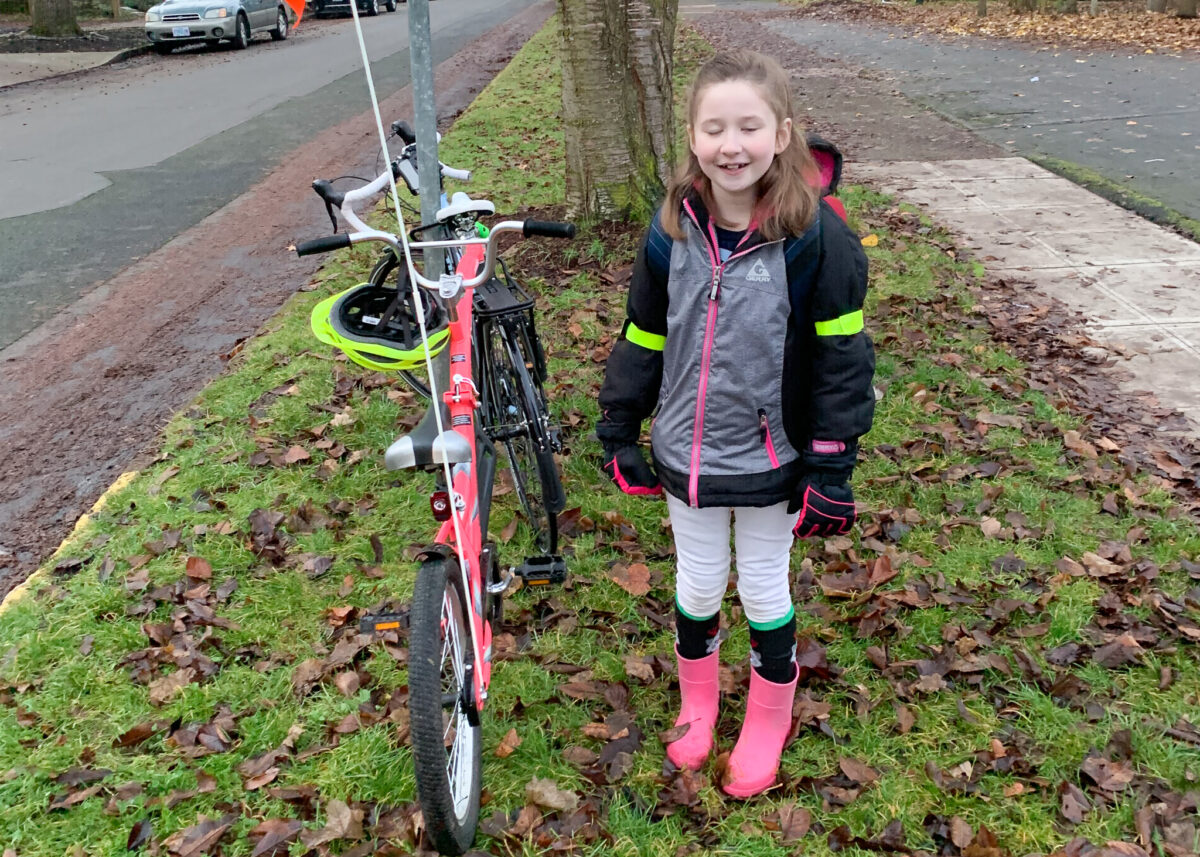
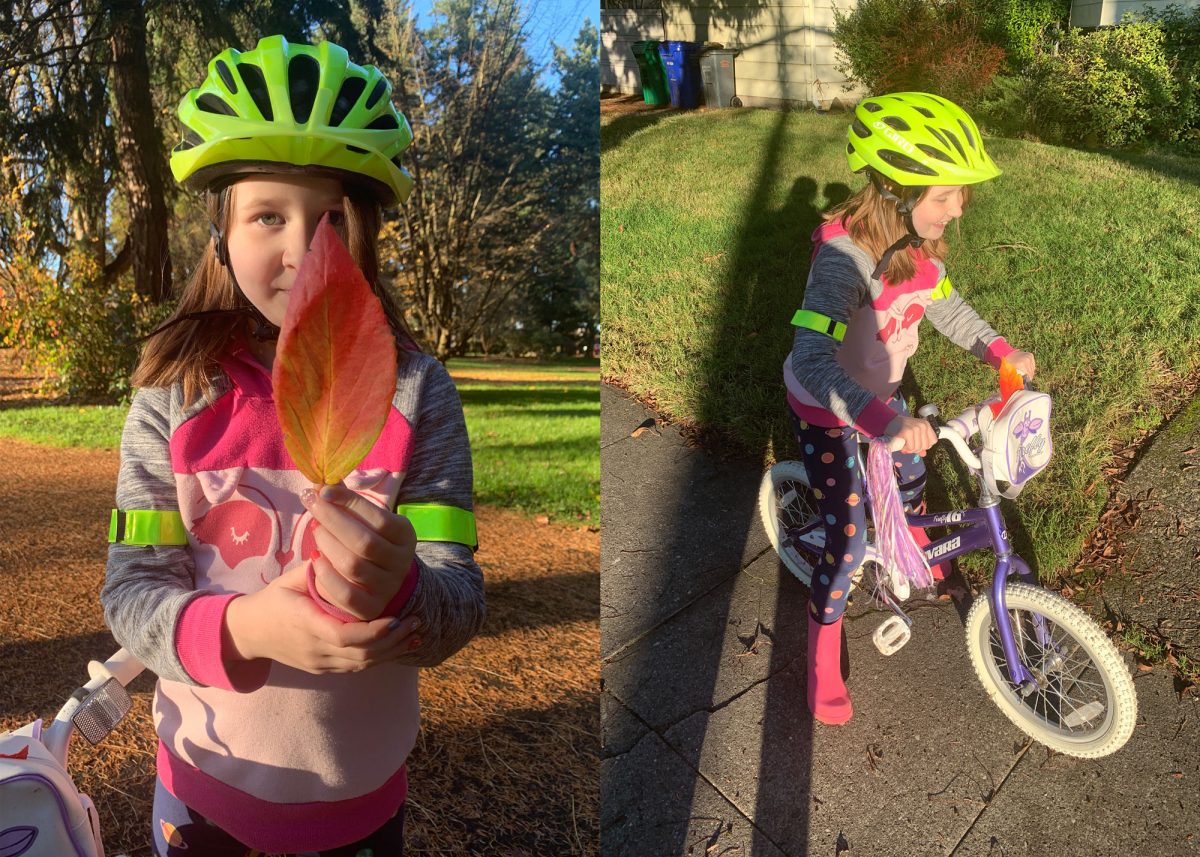
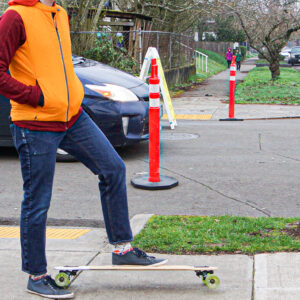
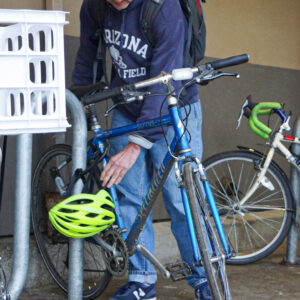

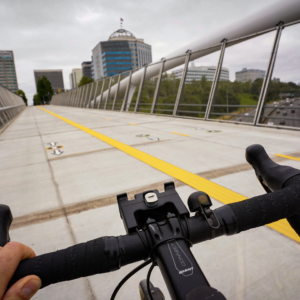
Thanks for reading.
BikePortland has served this community with independent community journalism since 2005. We rely on subscriptions from readers like you to survive. Your financial support is vital in keeping this valuable resource alive and well.
Please subscribe today to strengthen and expand our work.
Neither — I was waving to you.
I once used the bent left arm to signal a right turn on my ride to work and a motorist looked at me nonplussed then waved back. 🙂
I have also noted that there is some confusion about what that signal means among cyclists…I once saw someone use that signal and then turn _left_ – and he was teaching it to their kid! (I told at him to look it up in the manual, but he seemed pretty convinced he had it correct.)
All things considered, I think pointing right with your right arm to signal a right turn is the best way to make sure you will be understood by the largest group. The only exception for me is if I think there’s someone behind me in a position where the bent left arm will be more visible than pointing with my right arm.
Oregon Revised Statutes 811.405 calls this out explicitly: https://www.oregonlaws.org/ors/811.405
Stph
yup – def outmoded. 😀 thanks!
So, what you’re saying is, you have a tag-a-long for sale? 😉
I learned the hard knocks way, but you might look into the Community Cycling Center offering.https://communitycyclingcenter.org/community/bike-camp/
hahaha, right? I’ve just about got a stable full at this point. 😀
Thanks for the link! PP&R filled up in <24 hours, so I'll check 'em out.
I’ve seen the right arm raised in a 90 degree angle to indicate a left turn. And if that’s not crazy enough, I’ve seen it to indicate a right turn. I’m like, wow, how do you screw up that badly? I know that’s really judgemental, but interpreting hand signals requires judgement.
I really like the left point for left and right point for right. very straight forward and easier on the balance.
You’re right – I’m going to retrain myself & kids. I was doing right hand, right turn, but the teens who were tweens at the time had gone to bike camp and learned left arm at right angle for turn, so I reverted back. le sigh. seems to be confusion all around in my house. 😀
And don’t even get me started on the stop signal (because I’m a self starter). I have always done the left hand extended toward the ground – as specified in John’s link: https://www.oregonlaws.org/ors/811.395. But I’ve been informed that putting your fist between your shoulder blades is “more correct”. No, I’m not giving myself a half nelson.
wha? so… in wind and rain, not to mention a wobbly kid… we’re supposed to put a hand between our shoulder blades? For now, I ride next to her, or just to the side and back, and I signal for us both, but she’s not about to be able to do that…let alone me. I’m not that graceful.
Hi Becky Jo! Great post!
As a bike camp instructor and manager, I have some insight on why the Community Cycling Center teaches using the left arm for both left turn (pointed to the left) and right turn (turned up 90 degrees). At bike camp, the groups travel in a single file line with an instructor at the front and back of the line, because of this, having everyone signal using their left hand makes it easier for cars and bike riders to see what our intention is for the next intersection. Additionally, it’s helpful to teach the kids that this is the same way someone one would signal if they were driving in a car where the turn signal is out or broken.
One of my favorite things to see on the road are kids on tag-alongs, Extracycles, and sometimes even Yepps copy their parents and signal along with them.
I will second the preference for using the left arm. Since cars are mostly behind and to the left of cyclists, a signal with the right arm could be more easily overlooked. But if I am mainly signalling for bikes behind me, a point with right hand for a right turn is likely more easily understood.
It’s probably safest to do both.
This is going to sound super controversial, but my own experience constantly proves it out: do not signal right turns.
Or at least signal them extremely judiciously. What I have found is that on busier streets, if I indicate to following motorists that I am turning right, they will think, “oh, good, then I can turn right, too!”. 98% of drivers cut corners, even when they think they are not cutting corners, which means that in attempting a simultaneous right turn with a bicyclist, they will come uncomfortably close at the apex of the turn. In addition to this, most drivers are not aware of the conditions that will affect the space for a bicyclist to maneuver once the turn is completed. What I mean is, you might be turning from a street WITH a bike lane onto a street WITHOUT a bike lane, but the turning driver won’t realize this, and will habitually turn into the rightmost position on the destination street. As well, a driver will see a parked car on the destination street as natural street furniture and not recognize the constriction and hazard that it poses to a bicyclist. You can imagine the scenarios that could play out.
So rather than being helpful, signaling right turns has served me mostly as an invitation to drivers to please crowd me.
Oh, and don’t expect that signaling a right turn will alleviate any confusion about why you are slowing down. Most drivers are already itching to pass you and will seize the moment of your slow-down to zip past. Drivers that want to turn at the same place as you will suffer just enough confusion to want to see what you are doing first, which gives you the chance to complete your turn in peace.
THE EXCEPTIONS:
Ok, so now that I’ve made the drastic case, there are exceptions. If a driver is waiting to exit the street I’m turning right onto, I’ll give them an indication that they don’t have to wait for me to pass by before they proceed.
If there are other bicyclists behind me, I will signal for their benefit and to avoid being passed on the right just as I am turning (never pass to the right of anyone in a right-hand lane, including a bike lane, unless they are signaling left…).
If there is a pedestrian waiting to cross on the far side of an intersection and I’m turning right before I would reach them, I signal for their benefit.
If I am changing lanes from left to right, or re-entering a bike lane after moving out of it.
Generally, if I am going to enter somebody else’s right-of-way (or potential right-of-way), I signal the crap out of that move, as early and clearly as “practicable”. If my path will not cross the path or potential path of anyone else…nyeahhh—no.
I can already see the nesting capacity of the comment structure being exceeded…
Defensive driving. I’ll buy that for a dollar.
The “defensive driving” philosophy just puts the onus for avoiding crashes on the safer driver. It’s the dangerous driver’s responsibility to not hit me. “Defensive driving” just creates more victim blaming. And this whole daylight headlight thing? No thank you — I don’t want my car looking like a traffic cone lit up like a Christmas tree.
Keep your dollar.
The “defensive driving” philosophy just puts the onus for avoiding crashes on the safer driver. Where was it before? Maybe the problem is that people don’t realize this was always the case?
He who cares the most, works the hardest.
In any context.
What Hello Kitty doesn’t know is, in my mind, I secretly substitute the word “driver” to represent any vehicle operator. 😉
Yeah, but can you fly, Bobby?
Shut up about the extended version Lebowski.
El B – I totally get what you’re saying. In my almost 30 years of vehicle driving, I’ve pissed off two cyclists. One when I was 23 because I just didn’t see him from an unfamiliar car that I was driving, and one was about 10 years ago for this very reason – I took a right turn next to him, and his verbal, let’s call it, explanation, was I scared the sh*t out of him. I never did that again as a driver, but that’s a risky lesson to teach a driver. I *do* feel I need to teach the kid the proper rules before we discuss breaking them… but I appreciate the spelled out lesson. We’ll get to that one when she’s ready.
So my issues with any kind of hand signals on a bike is that…well…I’m already using my hands! Much of the time I have committed to using my hands to hold onto the handlebars, apply the brakes coming up to an intersection, etc. Maybe I have a few seconds when I could spare a hand to signal before I start to slow down for the intersection, but that requires a bit of advanced planning and won’t do any good by the time I’m actually at the intersection. The beauty of turn signals in a car is that you turn it on with a simple flick, then it stays on until you turn, whereas you need to continuously keep your hands in signaling position while on a bike. Is everybody else just better at riding one-handed? Personally I’m waiting for someone to invent flashing turn signal gloves that you can wear and activate the blinking lights in the respective hand coming up to a turn, without having to keep your hands off the handlebars.
I generally signal well before the turn, while I’m still going straight, then reapply my hands to the handlebars before making the actual turn.
“I can see what you’re doing, tell me what you’re going to do!”
Which is why I also say, “wheels don’t lie”.
“A headwind adds 20 pounds.”
I don’t know why this comment section is so much fun today.
I understand the concept of signaling before a turn, whether on a bike or in a car, but I feel like the timing is different. If I signal while driving approximately 100 feet before the intersection, I put the signal on and it stays on until I complete the turning maneuver. If I signal “well-ahead” of my turn while biking, (a) I can only have the signal visible for a few seconds before wanting to use my handlebars again, so anyone not looking at me in that time frame will have missed it, and (b) it can take a longer time to cover the 100 feet to the intersection on my bike than in my car, so the time delay between signal and turn becomes even longer.
Really, for me, I just don’t like to take my hands off the handlebars at almost any point, not just when I am actively turning. It would be nice to be able to signal with lights or some other device that would allow me to keep my hands on the handlebars while keeping the signal visible before and through the turn.
“If I’m cruising along a road and intend to turn left, no traffic behind me, and a single approaching driver is coming at me”
Ugh. I forgot about this case. It literally should never happen, but actually happens all the time. My biggest trouble spot is when turning left from Wilshire onto 96th to get to the US-26 MUP.
section (2) of ORS 814.440 has you covered.
I like signaling with broad, open gestures, both because it’s more obvious, but also because it makes me take up more room and gives me a bit more space.
This cannot be overstated. As in the rest of the animal kingdom, looking bigger draws attention. I also like to add a little flair by rotating my extended hand back and forth from horizontal to vertical; my mechanical flasher.
Yes, exactly. In winter, I usually wear one of these under my jacket. It seems to help.
I’ve tried that, but even in Winter, it gets too sweaty—and the added wind resistance is heck.
For Bike Camps, the CCC has been running them successfully for years.
https://communitycyclingcenter.org/community/bike-camp/
The CCC also runs the bike-themed OMSI camps.
https://secure.omsi.edu/camps-and-classes#type-formats=field-trip
Juuuuuust gonna put this… here…
https://youtu.be/MZMJIGPxPqI
I imagine if I tried to arm-bar another cyclist like that, I’d get my arm snatched off. Also, he literally pulled that helmet out of his ass.
Charleston SC. Nice town, I highly recommend it, very old (1630s).
I actually use the old school right turn (bent left arm) and pointing right arm interchangeably. I find that if I’m trying to communicate my turn to a cyclist behind me, I’ll use the old-school bike way, but if I’m mostly riding around vehicles, I’ll point because I don’t assume that all drivers know hand signals.
Also, for what it’s worth, I often point to a lane when I’m changing lanes or merging. For example, if I’m riding Hawthorne bridge west into downtown and need to merge over to make a left on second, I’ll use a lot of body language clues to tell drivers I want to merge. Mostly I start looking over my shoulder more frequently, and then kinda open my body and point left to the lane I’m merging into. (at a sort of 45 degree angle).
I’ve found that about 80% of the time, when I start looking over my shoulder a few times, cars can tell that I’m looking to merge and will back off to give me space, then I point and start to make my merge. Obviously use discretion, but I find it a pretty effective communication tool to drivers.
Can someone explain how best to signal when crossing Division from 21st and heading over onto Ladd?
Get out in the front of the bike box (don’t hang out over on the right, that’s not how they’re supposed to work), then take the lane, light you roman candle, and use it to signal an assertive right.
<>
Becky Jo, please DO NOT use your right arm to signal a right turn. The only reason I’m against it is because YOUR BODY is blocking the car behind/beside you from seeing that your right arm is extended out. Make sense? Left arm all the way.
Just traversed 21st onto Ladd riding the 10 bus this morning. There was one cyclist in the green box in front of the bus who went left, flipped up his bent left arm, smoothly eased onto Ladd. But it was unclear a priori if he intended to turn 90 degrees right onto 20th or 45 degrees onto Ladd.
Every cycle of the signals during morning commute ushers a dozen cyclists from 21st onto Ladd. Everyone, cyclists, motorists, TriMet operators, knows how the dance there works. Ladd itself could be a paradigm for mixed mode use. There is no formal structure, only sharrows. Ladd’s Addition, platted before the common use of cars, has no driveways; both sides of the street are dense with residential parking, even though there are alleys with garages. The resulting ROW is too narrow for two buses , so one must hold back to let the other pass. Even big pickups can evoke that ploy.
Due to recent legislation cyclists now have easy entrance to the Circle, also known as “Portland’s Other Velodrome.” Try a couple of laps before showing up for work! Roman candles optional.
Also recommended are tours of the extensive alleys. Just try to find your way out.
When traversing Division I employ neither standard arm signal, just point in the direction of Ladd, and ponder why “subtraction” and “multiplication” are lacking.
“But it was unclear a priori if he intended to turn 90 degrees right onto 20th or 45 degrees onto Ladd.”
This seems like one of those times when you would not want to signal a right.
Funny is noted. Seems to call for the alternative math of ambition, distraction, uglification and derision.
>>> But it was unclear a priori if he intended to turn 90 degrees right onto 20th or 45 degrees onto Ladd. <<<
I'm guessing that's because the cyclist wasn't using their roman candle properly, if at all.
But as long as a driver doesn't try to pass you in the intersection (this has only happened to me once in over a decade), it doesn't much matter whether you turn on to SE 20th or Ladd. If you use the bike box properly, you'll be out in front and can turn where you like without danger.
In Corvallis, I lead three Youth Bike Camps each summer. This year, there are:
• two basic camps: 6/22-26 and 7/13-17, and
• one advanced camp: 8/3-7
Each camp day starts at 8:30 am and goes to noon. We ride on city streets every day and do some trail riding, too.
I have years of experience teaching cycling to youth & children and am a Cycling Instructor trained and recognized by the League of American Bicyclists.
Participants will have fun while they:
• Build skill, confidence, independence.
• Ride safely in traffic.
• Learn to maintain a bike.
Register with Corvallis Parks & Recreation
http://www.corvallisoregon.gov/pr (541) 766-6918